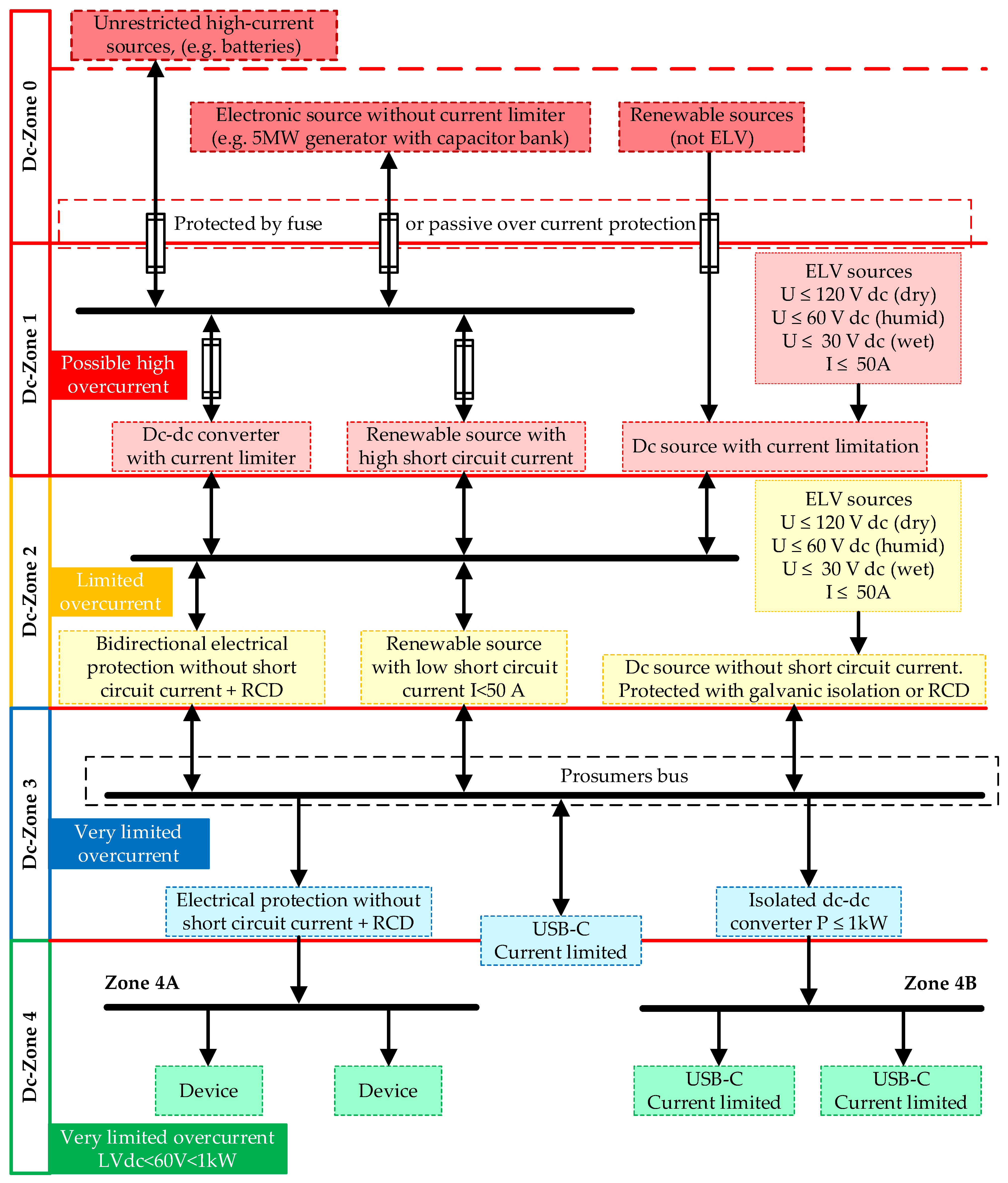Grounding and Isolation Requirements in DC Microgrids: Overview and Critical Analysis
Abstract
:1. Introduction
2. Protection and Safety in the DC Microgrid
3. Leakage Current in DC Systems
3.1. AC Leakage Current
3.2. DC Leakage Current
4. Grounding in the AC System
4.1. Grounding Type
4.2. Grounding Configurations
5. Grounding in DC Microgrids
5.1. Grounding Types
5.2. Grounding Configurations in DC Microgrids
- In the TN-C grounding mode, if the PEL or PEM wire is loose or has a weak connection, the body and metal parts of the equipment will be under line voltage. Therefore, regardless of the type of function, the TN-C structure should not be used in DC systems;
- In the TT mode, the resistance of the two ground paths limits the fault current. Therefore, if the body comes into contact with the line with potential and electric shock, short-circuit protection cannot be used as protection against electric shock. Neither is overcurrent protection a suitable option for protection against electric shock due to its slow response time;
- On the other hand, the use of the IT structure is usually preferred due to the continuity of operation in the event of a fault. This structure is suitable for skilled and trained personnel because it is not easy to detect and fix errors in this structure. The IT structure is also far from touch safety due to the presence of capacitors in EMC filters and existing cables and the creation of capacitive coupling with the ground;
- Based on the above, the risk classification in Figure 2, and the types of ground structures, the TN-S grounding structure is preferred in zones 1 to 3 and 4a;
- Systems in DC zone 4B are usually implemented as IT systems in practice because of the USB-C connection.
5.3. Impact of Grounding on the DC Leakage Current
5.4. Grounding Configuration for Several Decentralized Sources
6. Grounding in the Connection Point of the DC Microgrid to the AC Grid
6.1. Isolated Case
6.2. Non-Isolated Case
7. Conclusions
- In the connection with high-frequency isolation, there is still leakage current in different parts, and in the case of having ground in the AC side (TN or TT), it can be injected from the DC side to the AC grid through the stray inter-winding capacitor between the primary and secondary side of the transformer. A low-frequency transformer eliminates this pass completely;
- In both high-frequency and low-frequency isolation, a DC component in the leakage current can be created by DC voltage bias between the middle (or negative) point of the DC system and the neutral point of the AC system. In order to eliminate this, the configurations where there is no voltage bias between the neutral point of the AC system and the middle point of the DC system are recommended;
- Grounding based on the middle point based on the TN-S-CD type is a highly recommended solution in the DC system grounding. In addition to fault or minimization of electric shock, it eliminates the DC leakage current between the AC and the DC system;
- A non-isolated common-ground solution for interlinking DC and AC grids can be considered as an alternative cost-effective solution where the leakage current between the AC and the DC grid can be completely eliminated.
Funding
Conflicts of Interest
References
- Available online: https://energy.ec.europa.eu/topics/renewable-energy/renewable-energy-directive-targets-and-rules/renewable-energy-targets_en#the-2030-targets (accessed on 1 November 2023).
- Li, P. Energy storage is the core of renewable technologies. IEEE Nanotechnol. Mag. 2008, 2, 13–18. [Google Scholar] [CrossRef]
- Hamidieh, M.; Ghassemi, M. Microgrids and Resilience: A Review. IEEE Access 2022, 10, 106059–106080. [Google Scholar] [CrossRef]
- Najafzadeh, M.; Ahmadiahangar, R.; Husev, O.; Roasto, I.; Jalakas, T.; Blinov, A. Recent Contributions, Future Prospects and Limitations of Interlinking Converter Control in Hybrid AC/DC Microgrids. IEEE Access 2021, 9, 7960–7984. [Google Scholar] [CrossRef]
- Dragičević, T.; Lu, X.; Vasquez, J.C.; Guerrero, J.M. DC Microgrids—Part II: A Review of Power Architectures, Applications, and Standardization Issues. IEEE Trans. Power Electron. 2015, 31, 3528–3549. [Google Scholar] [CrossRef]
- Kumar, D.; Zare, F.; Ghosh, A. DC Microgrid Technology: System Architectures, AC Grid Interfaces, Grounding Schemes, Power Quality, Communication Networks, Applications, and Standardizations Aspects. IEEE Access 2017, 5, 12230–12256. [Google Scholar] [CrossRef]
- Gelani, H.E.; Dastgeer, F.; Nasir, M.; Khan, S.; Guerrero, J.M. Ac vs. dc distribution efficiency: Are we on the right path? Energies 2021, 14, 4039. [Google Scholar] [CrossRef]
- Sahoo, S.K.; Sinha, A.K.; Kishore, N.K. Control techniques in AC, DC, and hybrid AC–DC microgrid: A review. IEEE J. Emerg. Sel. Top. Power Electron. 2017, 6, 738–759. [Google Scholar] [CrossRef]
- Chen, M.; Ma, S.; Wan, H.; Wu, J.; Jiang, Y. Distributed Control Strategy for DC Microgrids of Photovoltaic Energy Storage Systems in Off-Grid Operation. Energies 2018, 11, 2637. [Google Scholar] [CrossRef]
- Aluisio, B.; Bruno, S.; De Bellis, L.; Dicorato, M.; Forte, G.; Trovato, M. DC-microgrid operation planning for an electric vehicle supply infrastructure. Appl. Sci. 2019, 9, 2687. [Google Scholar] [CrossRef]
- Carvalho, E.L.; Blinov, A.; Chub, A.; Emiliani, P.; de Carne, G.; Vinnikov, D. Grid Integration of DC Buildings: Standards, Requirements and Power Converter Topologies. IEEE Open J. Power Electron. 2022, 3, 798–823. [Google Scholar] [CrossRef]
- NPapanikolaou; Kyritsis, A.; Loupis, M.; Tzotzos, C.; Zoga, E. Design Considerations for Single-Phase Line Frequency Transformers Applied at Photovoltaic Systems. IEEE Power Energy Technol. Syst. J. 2015, 2, 82–93. [Google Scholar] [CrossRef]
- Hannan, M.A.; Ker, P.J.; Lipu, M.S.H.; Choi, Z.H.; Rahman, M.S.A.; Muttaqi, K.M.; Blaabjerg, F. State of the Art of Solid-State Transformers: Advanced Topologies, Implementation Issues, Recent Progress and Improvements. IEEE Access 2020, 8, 19113–19132. [Google Scholar] [CrossRef]
- She, X.; Huang, A.Q.; Burgos, R. Review of Solid-State Transformer Technologies and Their Application in Power Distribution Systems. IEEE J. Emerg. Sel. Top. Power Electron. 2013, 1, 186–198. [Google Scholar] [CrossRef]
- Ryu, M.-H.; Kim, H.-S.; Baek, J.-W.; Kim, H.-G.; Jung, J.-H. Effective Test Bed of 380-V DC Distribution System Using Isolated Power Converters. IEEE Trans. Ind. Electron. 2015, 62, 4525–4536. [Google Scholar] [CrossRef]
- IEEE Std 1547a-2020; IEEE Standard for Interconnection and Interoperability of Distributed Energy Resources with Associated Electric Power Systems Interfaces--Amendment 1: To Provide More Flexibility for Adoption of Abnormal Operating Performance Category III. (Amendment to IEEE Std 1547-2018). IEEE: Piscataway, NJ, USA, 15 April 2020; pp. 1–16. [CrossRef]
- Rivera, S.; Lizana, F.R.; Kouro, S.; Dragičević, T.; Wu, B. Bipolar DC Power Conversion: State-of-the-Art and Emerging Technologies. IEEE J. Emerg. Sel. Top. Power Electron. 2021, 9, 1192–1204. [Google Scholar] [CrossRef]
- Dey, S.; Bussa, V.K.; Singh, R.K. Transformerless Hybrid Converter With AC and DC Outputs and Reduced Leakage Current. IEEE J. Emerg. Sel. Top. Power Electron. 2019, 7, 1329–1341. [Google Scholar] [CrossRef]
- Buticchi, G.; Barater, D.; Lorenzani, E.; Franceschini, G. Digital Control of Actual Grid-Connected Converters for Ground Leakage Current Reduction in PV Transformerless Systems. IEEE Trans. Ind. Inform. 2012, 8, 563–572. [Google Scholar] [CrossRef]
- TOliveira, R.; Silva, W.W.A.G.; Seleme, S.I.; Donoso-Garcia, P.F. PLL-Based Feed-Forward Control to Attenuate Low-Frequency Common-Mode Voltages in Transformerless LVDC Systems. IEEE Trans. Ind. Appl. 2019, 55, 3151–3159. [Google Scholar] [CrossRef]
- Qiu, J.; He, Y.; Lei, C.; Jiao, Q.; Liu, J. An Improved LMSVM Method for Leakage Current Suppression and Neutral-Point Voltage Control in Transformerless NPC Three-Level Inverters. IEEE J. Emerg. Sel. Top. Power Electron. 2022, 10, 3100–3113. [Google Scholar] [CrossRef]
- Zhou, L.; Gao, F.; Xu, T. Implementation of Active NPC Circuits in Transformer-Less Single-Phase Inverter With Low Leakage Current. IEEE Trans. Ind. Appl. 2017, 53, 5658–5667. [Google Scholar] [CrossRef]
- Iturriaga-Medina, S.; Martinez-Rodriguez, P.R.; Escobar-Valderrama, G.; Vazquez-Guzman, G.; Langarica-Cordoba, D.; Rosas-Caro, J.C.; Sosa-Zuniga, J.M.; Mayo-Maldonado, J.C. Leakage-Ground Currents Compensation in a Transformerless HB-NPC Topology Using a DC-Link-Tied LC Filter for Photovoltaic Applications. IEEE J. Emerg. Sel. Top. Power Electron. 2022, 10, 4725–4737. [Google Scholar] [CrossRef]
- Escobar, G.; Martinez-Rodriguez, P.R.; Iturriaga-Medina, S.; Mayo-Maldonado, J.C.; Lopez-Sarabia, J.; Micheloud-Vernackt, O.M. Mitigation of Leakage-Ground Currents in Transformerless Grid-Tied Inverters via Virtual-Ground Connection. IEEE J. Emerg. Sel. Top. Power Electron. 2019, 8, 3111–3123. [Google Scholar] [CrossRef]
- Mohammadi, J.; Ajaei, F.B.; Stevens, G. Grounding the DC Microgrid. IEEE Trans. Ind. Appl. 2019, 55, 4490–4499. [Google Scholar] [CrossRef]
- Pourmirasghariyan, M.; Zarei, S.F.; Hamzeh, M. DC-system grounding: Existing strategies, performance analysis, functional characteristics, technical challenges, and selection criteria-a review. Electr. Power Syst. Res. 2022, 206, 107769. [Google Scholar] [CrossRef]
- Park, J. Ground fault detection and location for ungrounded DC traction power systems. IEEE Trans. Veh. Technol. 2015, 64, 5667–5676. [Google Scholar] [CrossRef]
- Beheshtaein, S.; Cuzner, R.M.; Forouzesh, M.; Savaghebi, M.; Guerrero, J.M. DC Microgrid Protection: A Comprehensive Review. IEEE J. Emerg. Sel. Top. Power Electron. 2019. [Google Scholar] [CrossRef]
- Rahimpour, S.; Husev, O.; Vinnikov, D. Design and Analysis of a DC Solid-State Circuit Breaker for Residential Energy Router Application. Energies 2022, 15, 9434. [Google Scholar] [CrossRef]
- Park, J.-D.; Candelaria, J. Fault Detection and Isolation in Low-Voltage DC-Bus Microgrid System. IEEE Trans. Power Deliv. 2013, 28, 779–787. [Google Scholar] [CrossRef]
- Xu, L.; Guerrero, J.M.; Lashab, A.; Wei, B.; Bazmohammadi, N.; Vasquez, J.C.; Abusorrah, A. A Review of DC Shipboard Microgrids—Part II: Control Architectures, Stability Analysis, and Protection Schemes. IEEE Trans. Power Electron. 2021, 37, 4105–4120. [Google Scholar] [CrossRef]
- Sheikh, A.A.; Wakode, S.A.; Deshmukh, R.R.; Ballal, M.S.; Suryawanshi, H.M.; Mishra, M.K.; Kumar, S. A Brief Review on DC Microgrid Protection. In Proceedings of the 2020 IEEE First International Conference on Smart Technologies for Power, Energy and Control (STPEC), Nagpur, India, 25–26 September 2020; pp. 1–6. [Google Scholar] [CrossRef]
- Zhang, L.; Tai, N.; Huang, W.; Liu, J.; Wang, Y. A review on protection of DC microgrids. J. Mod. Power Syst. Clean Energy 2018, 6, 1113–1127. [Google Scholar] [CrossRef]
- Mohanty, R.; Pradhan, A.K. Protection of DC and hybrid AC-DC microgrids with ring configuration. In Proceedings of the 2017 7th International Conference on Power Systems (ICPS), Pune, India, 21–23 December 2017; pp. 607–612. [Google Scholar] [CrossRef]
- Noritake, M.; Iino, T.; Fukui, A.; Hirose, K.; Yamasaki, M. A study of the safety of the DC 400 V distribution system. In Proceedings of the INTELEC 2009—31st International Telecommunications Energy Conference, Incheon, Republic of Korea, 18–22 October 2009; pp. 1–6. [Google Scholar] [CrossRef]
- Husev, O.; Matiushkin, O.; Vinnikov, D.; Roncero-Clemente, C.; Kouro, S. Novel Concept of Solar Converter With Universal Applicability for DC and AC Microgrids. IEEE Trans. Ind. Electron. 2021, 69, 4329–4341. [Google Scholar] [CrossRef]
- Husev, O.; Vinnikov, D.; Kouro, S.; Blaabjerg, F.; Roncero-Clemente, C. Dual-Purpose Converters for DC or AC Grid as Energy Transition Solution: Perspectives and Challenges. IEEE Ind. Electron. Mag. 2023, 2–13. [Google Scholar] [CrossRef]
- Vygoder, M.; Milton, M.; Gudex, J.D.; Cuzner, R.M.; Benigni, A. A Hardware-in-the-Loop Platform for DC Protection. IEEE J. Emerg. Sel. Top. Power Electron. 2020, 9, 2605–2619. [Google Scholar] [CrossRef]
- Liu, Y.-C.; Lin, C.-Y. Insulation fault detection circuit for ungrounded DC power supply systems. In Proceedings of the 2012 IEEE, SENSORS, Taipei, Taiwan, 28–31 October 2012; pp. 1–4. [Google Scholar] [CrossRef]
- Salomonsson, D.; Soder, L.; Sannino, A. Protection of Low-Voltage DC Microgrids. IEEE Trans. Power Deliv. 2009, 24, 1045–1053. [Google Scholar] [CrossRef]
- Standard NPR 9090:2018; DC Installations for low Voltage. Royal Dutch Standardization Institute (NEN): Delft, The Netherlands, 2018.
- Blinov, A.; Roasto, I.; Chub, A.; Emiliani, P.; Vinnikov, D. Electric Power Management and Control in DC Buildings—State-Of-The-Art and Emerging Technologies. In Power Quality: Infrastructures and Control; Springer: Singapore, 2023; pp. 67–96. [Google Scholar]
- Li, W.; Gu, Y.; Luo, H.; Cui, W.; He, X.; Xia, C. Topology Review and Derivation Methodology of Single-Phase Transformerless Photovoltaic Inverters for Leakage Current Suppression. IEEE Trans. Ind. Electron. 2015, 62, 4537–4551. [Google Scholar] [CrossRef]
- Gu, Y.; Li, W.; Zhao, Y.; Yang, B.; Li, C.; He, X. Transformerless Inverter with Virtual DC Bus Concept for Cost-Effective Grid-Connected PV Power Systems. IEEE Trans. Power Electron. 2012, 28, 793–805. [Google Scholar] [CrossRef]
- Khan, M.N.H.; Forouzesh, M.; Siwakoti, Y.P.; Li, L.; Kerekes, T.; Blaabjerg, F. Transformerless Inverter Topologies for Single-Phase Photovoltaic Systems: A Comparative Review. IEEE J. Emerg. Sel. Top. Power Electron. 2019, 8, 805–835. [Google Scholar] [CrossRef]
- Demetriou, A.; Buxton, D.; Charalambous, C.A. Stray Current DC Corrosion Blind Spots Inherent to Large PV Systems Fault Detection Mechanisms: Elaboration of a Novel Concept. IEEE Trans. Power Deliv. 2016, 33, 3–11. [Google Scholar] [CrossRef]
- Dimitriou, A.; Charalambous, C.A. DC Interference Modeling for Assessing the Impact of Sustained DC Ground Faults of Photovoltaic Systems on Third-Party Infrastructure. IEEE Trans. Ind. Electron. 2018, 66, 2935–2945. [Google Scholar] [CrossRef]
- Wu, Y.; Zhang, P. A Novel Online Monitoring Scheme for Underground Power Cable Insulation Based on Common-Mode Leakage Current Measurement. IEEE Trans. Ind. Electron. 2022, 69, 13586–13596. [Google Scholar] [CrossRef]
- IEC 60950 Standard. Available online: https://webstore.iec.ch/publication/4020 (accessed on 1 November 2023).
- IEEE Std 1547-2018; IEEE Standard for Interconnection and Interoperability of Distributed Energy Resources with Associated Electric Power Systems Interfaces. (Revision of IEEE Std 1547-2003). IEEE: Piscataway, NJ, USA, 6 April 2018; pp. 1–138. [CrossRef]
- Mohammadi, J.; Ajaei, F.B.; Stevens, G. Grounding the AC Microgrid. IEEE Trans. Ind. Appl. 2019, 55, 98–105. [Google Scholar] [CrossRef]
- Yang, J.; Xiao, X.; Su, W.; Si, X.; Zhang, J.; Zhang, X. Comparison of Grounding Modes of MMC-Based Flexible DC Distribution System. IEEE Access 2021, 9, 19696–19706. [Google Scholar] [CrossRef]
- IEC 60364-1; Low-Voltage Electrical Installations—Part 1: Fundamental Principles, Assessment of General Characteristics, Definitions. International Electrotechnical Commission: Geneva, Switzerland, 2005.
- Sattari, P.; Panetta, S. High-Resistance Grounding Design for Industrial Facilities: Providing Continuity of Service in Complex Distribution Systems. IEEE Ind. Appl. Mag. 2019, 26, 18–27. [Google Scholar] [CrossRef]
- Lopez-Sarabia, J.; Valderrama, G.E.; Martinez-Rodriguez, P.R.; Iturriaga-Medina, S.; Mayo-Maldonado, J.C.; Puerto-Flores, D.D. DC-Link Capacitors’ Voltage Balance in an HB-NPC Five-Level Grid-Tied Inverter via the Common-Mode Control Component. IEEE J. Emerg. Sel. Top. Power Electron. 2021, 10, 3242–3255. [Google Scholar] [CrossRef]
- Valdes, M.; Papallo, T.; Premerlani, B. Finding fault—Locating a ground fault in low-voltage, high-resistance grounded systems via the single-processor concept for circuit protection. IEEE Ind. Appl. Mag. 2007, 13, 24–30. [Google Scholar] [CrossRef]
- Paul, D. DC traction power system grounding. IEEE Trans. Ind. Appl. 2002, 38, 818–824. [Google Scholar] [CrossRef]
- Mobarrez, M.; Fregosi, D.; Bhattacharya, S.; Bahmani, M.A. Grounding architectures for enabling ground fault ride-through capability in DC microgrids. In Proceedings of the 2017 IEEE Second International Conference on DC Microgrids (ICDCM), Nuremburg, Germany, 27–29 June 2017; pp. 81–87. [Google Scholar] [CrossRef]
- Naghizadeh, M.; Farjah, E.; Ghanbari, T.; Pourgharibshahi, H.; Andani, M.T. Efficient Grounding Method for DC Microgrid with Multiple Grounding Points. In Proceedings of the 2018 Clemson University Power Systems Conference (PSC), Charleston, SC, USA, 4–7 September 2018; pp. 1–6. [Google Scholar] [CrossRef]
- Karppanen, J.; Kaipia, T.; Mattsson, A.; Nuutinen, P.; Kim, J.; Cho, J.; Peltoniemi, P.; Partanen, J.; Lana, A.; Pinomaa, A. Effect of Voltage Level Selection on Earthing and Protection of LVDC Distribution Systems. In Proceedings of the 11th IET International Conference on AC and DC Power Transmission, Birmingham, UK, 10–12 February 2015; pp. 1–8. [Google Scholar] [CrossRef]
- Yang, J.; Fletcher, J.E.; O’Reilly, J. Short-circuit and ground fault analyses and location in VSC-based DC network cables. IEEE Trans. Ind. Electron. 2012, 59, 3827–3837. [Google Scholar] [CrossRef]
- Jacobson, B.; Walker, J. Grounding considerations for DC and mixed DC and AC power systems. Naval Eng. J. 2007, 119, 49–62. [Google Scholar] [CrossRef]
- Hirose, K.; Tanaka, T.; Babasaki, T.; Person, S.; Foucault, O.; Sonnenberg, B.J.; Szpek, M. Grounding concept considerations and recommendations for 400VDC distribution system. In Proceedings of the 2011 IEEE 33rd International Telecommunications Energy Conference (INTELEC), Amsterdam, The Netherlands, 9–13 October 2011; pp. 1–8. [Google Scholar] [CrossRef]
- Mackay, L.; Martinez, K.F.Y.; Vandeventer, E.; Ramirez-Elizondo, L.; Bauer, P. Capacitive grounding for DC distribution grids with two grounding points. In Proceedings of the 2017 IEEE Second International Conference on DC Microgrids (ICDCM), Nuremburg, Germany, 27–29 June 2017; pp. 76–80. [Google Scholar] [CrossRef]
- Saleh, S.A.; Kanukollu, S.; Al-Durra, A. Performance Assessment of Frequency Selective Grounding for Grid-Connected Photovoltaic Systems. IEEE Trans. Power Deliv. 2022, 38, 1138–1147. [Google Scholar] [CrossRef]
- Zhang, W.; Wei, T.; Chen, Q.; Cui, Y.; Liu, W.; Yang, J. Study on Grounding Modes of AC/DC Hybrid Distribution System. In Proceedings of the 2019 IEEE International Conference on Energy Internet (ICEI), Nanjing, China, 27–31 May 2019; pp. 42–46. [Google Scholar] [CrossRef]
- Lu, H.Y.; Zhu, J.G.; Hui, S. Experimental determination of stray capacitances in high frequency transformers. IEEE Trans. Power Electron. 2003, 18, 1105–1112. [Google Scholar] [CrossRef]
- Fu, K.; Chen, W.; Lin, S. A general transformer evaluation method for common-mode noise behavior. Energies 2019, 12, 1984. [Google Scholar] [CrossRef]
- de Oliveira, T.R.; Bolzon, A.S.; Donoso-Garcia, P.F. Grounding and safety considerations for residential DC microgrids. In Proceedings of the IECON 2014—40th Annual Conference of the IEEE Industrial Electronics Society, Dallas, TX, USA, 29 October–1 November 2014; pp. 5526–5532. [Google Scholar] [CrossRef]
- Zhang, D.; Cao, D.; Huber, J.; Everts, J.; Kolar, J.W. Non-Isolated Three-Phase Current DC-Link Buck-Boost EV Charger with Virtual Output Midpoint Grounding and Ground Current Control. IEEE Trans. Transp. Electrif. 2023. [Google Scholar] [CrossRef]
- Roncero-Clemente, C.; Husev, O.; Matiushkin, O.; Gutierrez-Escalona, J.; Barrero-Gonzalez, F.; Vinnikov, D.; Strzelecki, R. Feasibility Study of Three-Phase Modular Converter for Dual-Purpose Application in DC and AC Microgrids. IEEE J. Emerg. Sel. Top. Power Electron. 2023. [Google Scholar] [CrossRef]
- Lee, S.S.; Lim, C.S.; Siwakoti, Y.P.; Lee, K.-B. Single-Stage Common-Ground Boost Inverter (S2CGBI) for Solar Photovoltaic Systems. In Proceedings of the 2019 IEEE Energy Conversion Congress and Exposition (ECCE), Baltimore, MD, USA, 29 September–3 October 2019; pp. 4229–4233. [Google Scholar]
- Lee, S.S.; Yang, Y.; Siwakoti, Y.P. A Novel Single-Stage FiveLevel Common-Ground-Boost-Type Active Neutral-Point-Clamped (5L-CGBT-ANPC) Inverter. IEEE Trans. Power Electron. 2021, 36, 6192–6196. [Google Scholar] [CrossRef]
- Vosoughi, N.; Hosseini, S.H.; Sabahi, M. A New Single-Phase Transformerless Grid-Connected Inverter With Boosting Ability and Common Ground Feature. IEEE Trans. Ind. Electron. 2019, 67, 9313–9325. [Google Scholar] [CrossRef]
- Shahsavar, T.H.; Kurdkandi, N.V.; Husev, O.; Babaei, E.; Sabahi, M.; Khoshkbar-Sadigh, A.; Vinnikov, D. A New Flying Capacitor-Based Buck–Boost Converter for Dual-Purpose Applications. IEEE J. Emerg. Sel. Top. Ind. Electron. 2023, 4, 447–459. [Google Scholar] [CrossRef]
- Azizi, M.; Rahimpour, S.; Husev, O.; Veligorskyi, O. Back-to-Back Energy Router Based on Common-Ground Inverters. In Proceedings of the 2023 IEEE 17th International Conference on Compatibility, Power Electronics and Power Engineering (CPE-POWERENG), Tallinn, Estonia, 14–16 June 2023; pp. 1–6. [Google Scholar] [CrossRef]
- Barzegarkhoo, R.; Siwakoti, Y.P.; Vosoughi, N.; Blaabjerg, F. Six-Switch Step-Up Common-Grounded Five-Level Inverter With Switched-Capacitor Cell for Transformerless Grid-Tied PV Applications. IEEE Trans. Ind. Electron. 2020, 68, 1374–1387. [Google Scholar] [CrossRef]
- Husev, O.; Kurdkandi, N.V.; Marangalu, M.G.; Vinnikov, D.; Hosseini, S.H. A New Single-Phase Flying Inductor-Based Common Grounded Converter for Dual-Purpose Application. IEEE Trans. Ind. Electron. 2023, 70, 7913–7923. [Google Scholar] [CrossRef]
- Barzegarkhoo, R.; Lee, S.S.; Siwakoti, Y.P.; Khan, S.A.; Blaabjerg, F. Design, Control, and Analysis of a Novel Grid-Interfaced Switched-Boost Dual T-Type Five-Level Inverter With Common-Ground Concept. IEEE Trans. Ind. Electron. 2021, 68, 8193–8206. [Google Scholar] [CrossRef]
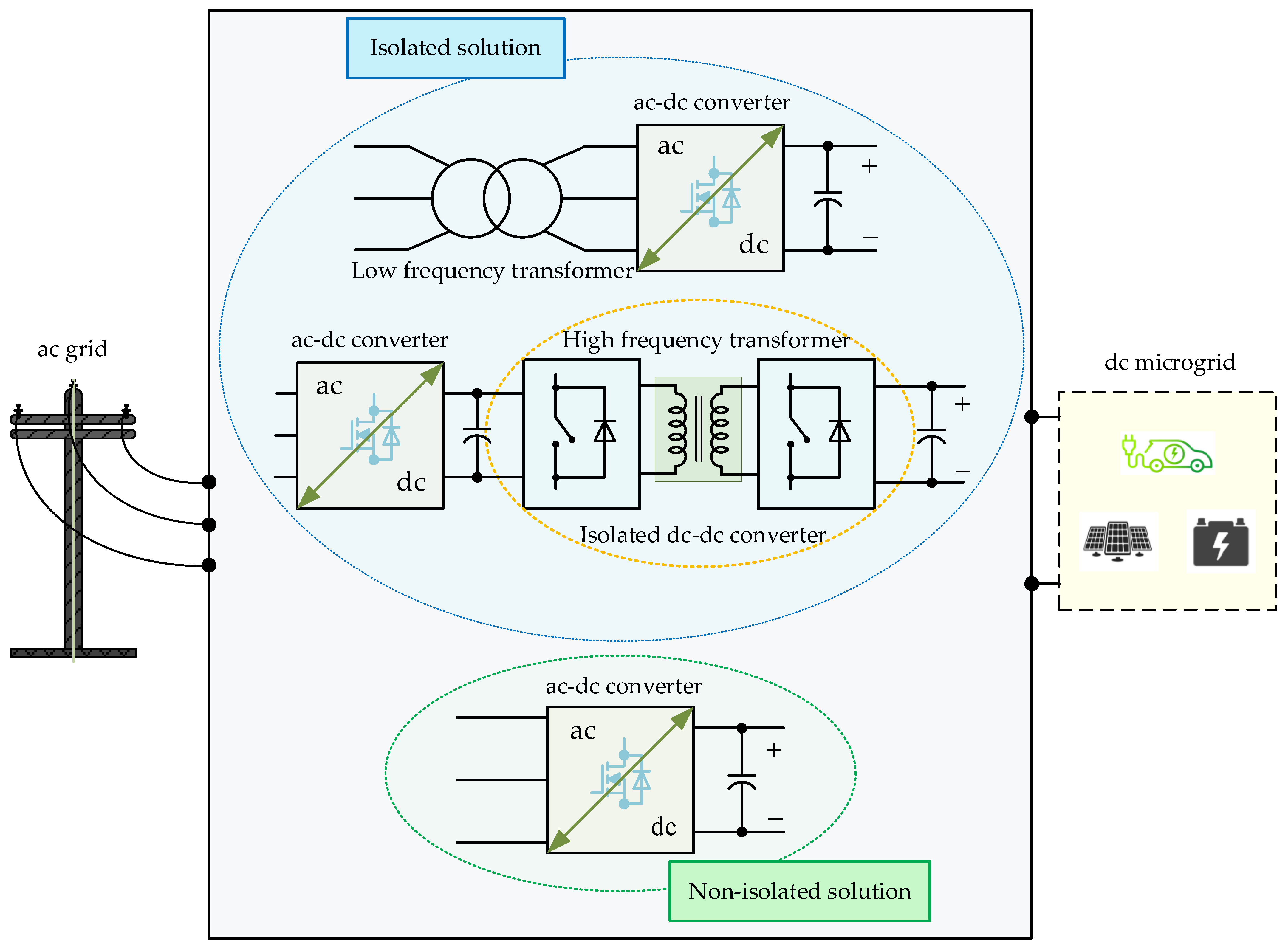







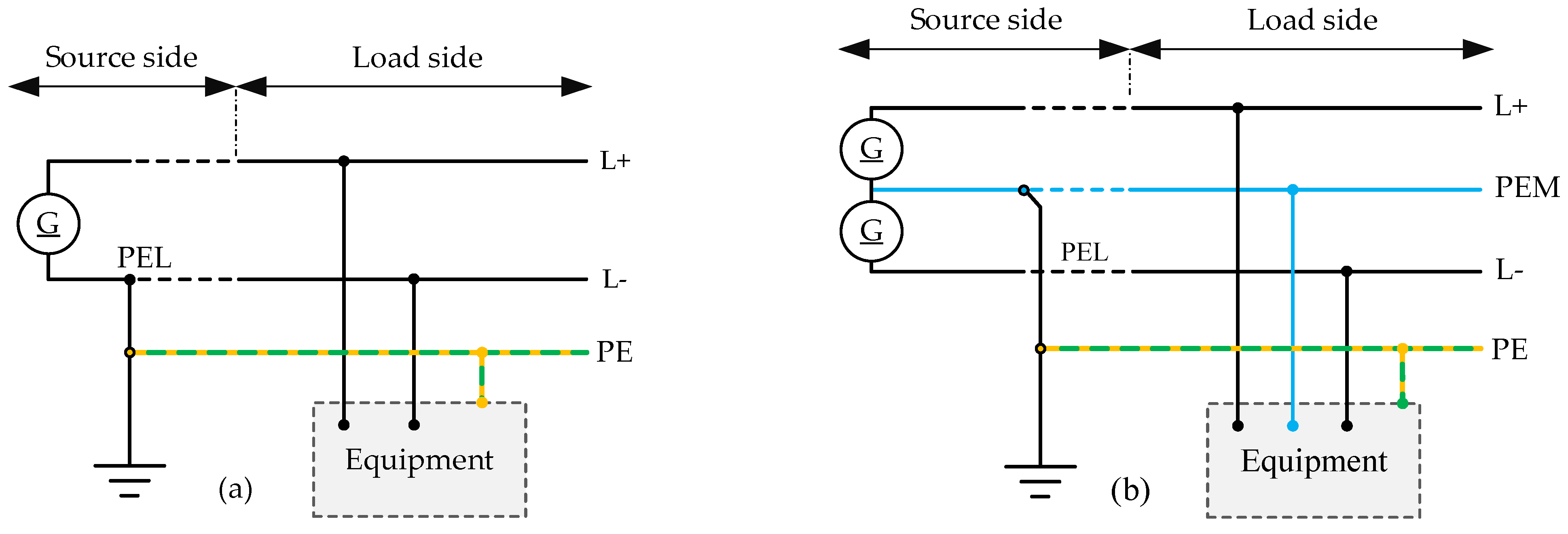

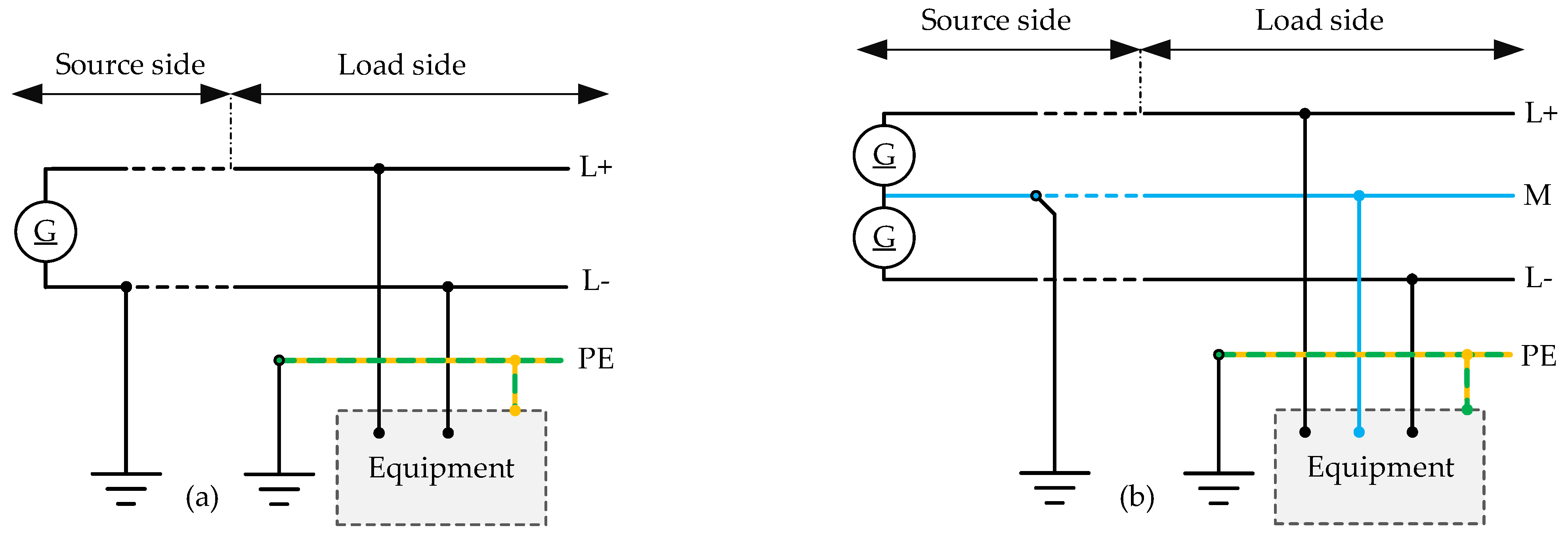
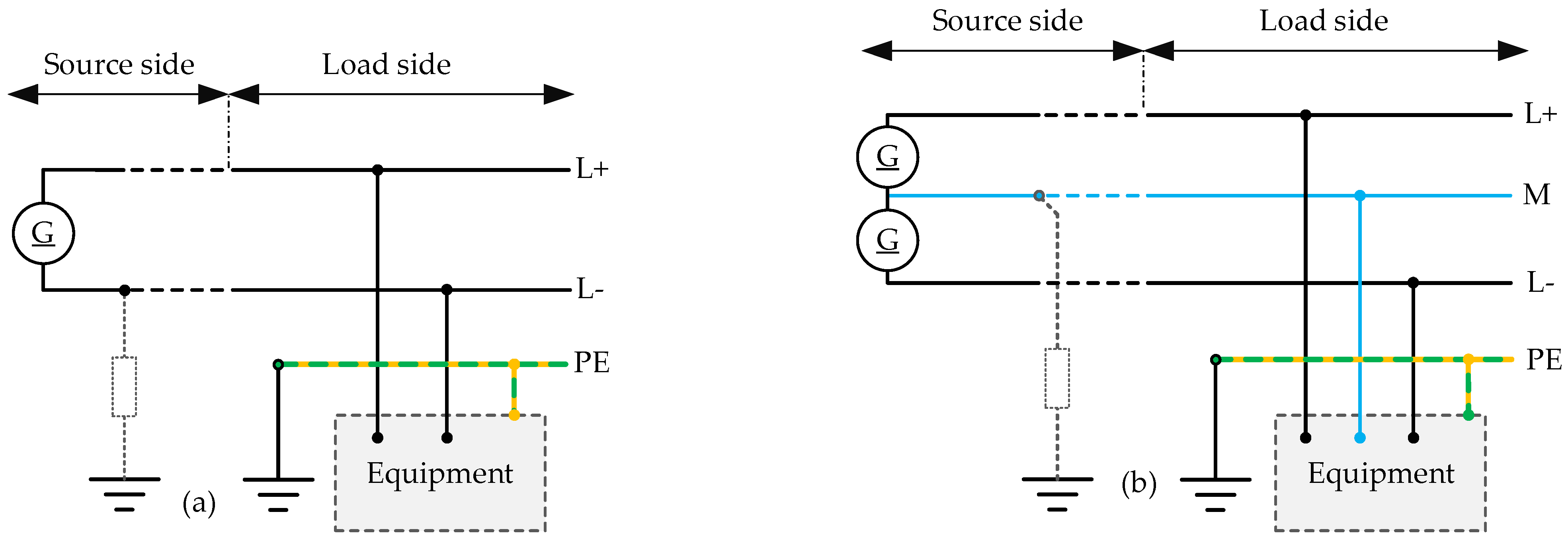
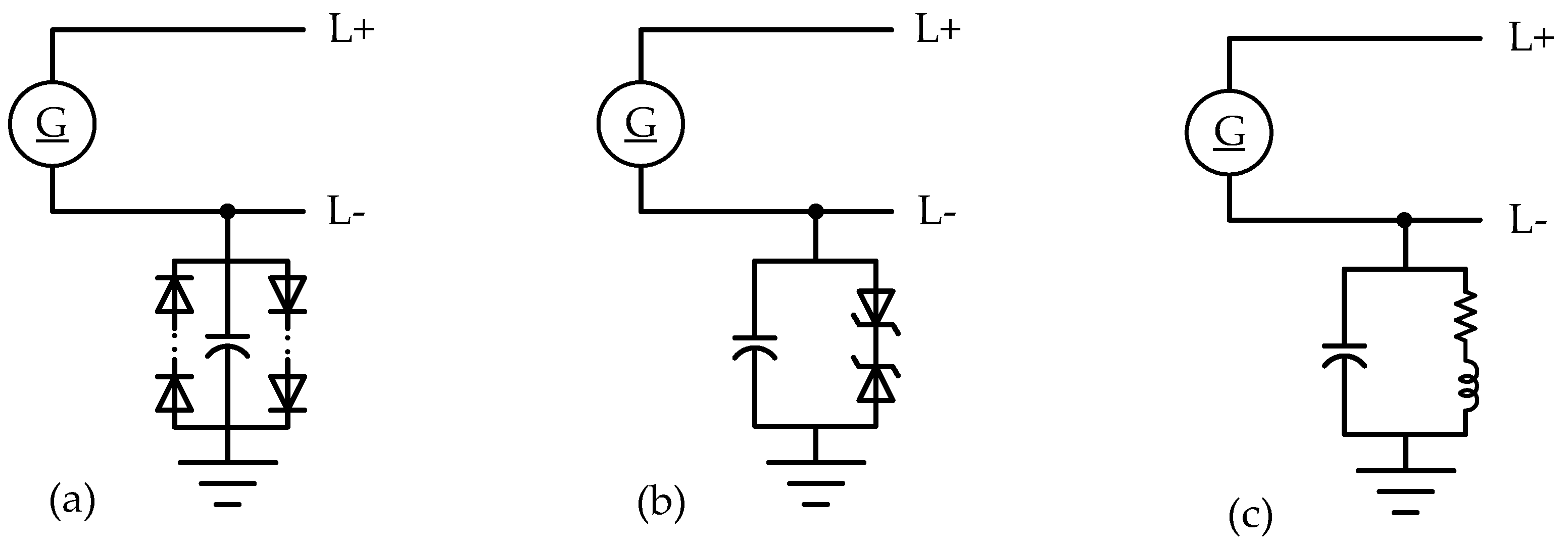





| Grounding Device | Advantages and Disadvantages |
|---|---|
| Ungrounded |
|
| Solidly grounded |
|
| Resistance grounded |
|
| Reactor grounded |
|
| Zigzag Grounded |
|
| Topology | Advantage | Disadvantage |
|---|---|---|
| TN |
|
|
| TT |
|
|
| IT |
|
|
| HRG |
|
|
| Grounding Type | Advantage | Disadvantage |
|---|---|---|
| Ungrounded |
|
|
| Solidly Grounded |
|
|
| High-Resistance Grounded |
|
|
| Low-Resistance Grounded |
|
|
| Diode Grounded |
|
|
| Thyristor Grounded |
|
|
| Grounding Configs | Safety of Personnel | Safety of Equipment | Continuity of Service | EMC |
|---|---|---|---|---|
| TN-S | Good |
| Average |
|
| TN-C | Good |
| Average |
|
| TT | Good |
| Average |
|
| IT | Good |
| Excellent |
|
| AC GND | TN (Any Kind) | TT | IT | |
|---|---|---|---|---|
| DC GND | ||||
| Negative point grounded | Forbidden | Forbidden | Possible | |
| Middle point grounded | Forbidden | Forbidden | Possible | |
| Ungrounded | Possible | Possible | Possible | |
Disclaimer/Publisher’s Note: The statements, opinions and data contained in all publications are solely those of the individual author(s) and contributor(s) and not of MDPI and/or the editor(s). MDPI and/or the editor(s) disclaim responsibility for any injury to people or property resulting from any ideas, methods, instructions or products referred to in the content. |
© 2023 by the authors. Licensee MDPI, Basel, Switzerland. This article is an open access article distributed under the terms and conditions of the Creative Commons Attribution (CC BY) license (https://creativecommons.org/licenses/by/4.0/).
Share and Cite
Azizi, M.; Husev, O.; Veligorskyi, O.; Rahimpour, S.; Roncero-Clemente, C. Grounding and Isolation Requirements in DC Microgrids: Overview and Critical Analysis. Energies 2023, 16, 7747. https://doi.org/10.3390/en16237747
Azizi M, Husev O, Veligorskyi O, Rahimpour S, Roncero-Clemente C. Grounding and Isolation Requirements in DC Microgrids: Overview and Critical Analysis. Energies. 2023; 16(23):7747. https://doi.org/10.3390/en16237747
Chicago/Turabian StyleAzizi, Mohammadreza, Oleksandr Husev, Oleksandr Veligorskyi, Saeed Rahimpour, and Carlos Roncero-Clemente. 2023. "Grounding and Isolation Requirements in DC Microgrids: Overview and Critical Analysis" Energies 16, no. 23: 7747. https://doi.org/10.3390/en16237747
APA StyleAzizi, M., Husev, O., Veligorskyi, O., Rahimpour, S., & Roncero-Clemente, C. (2023). Grounding and Isolation Requirements in DC Microgrids: Overview and Critical Analysis. Energies, 16(23), 7747. https://doi.org/10.3390/en16237747






